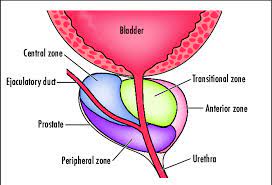The prostate is an organ about the size of a chestnut and weighs around 30 grams (around 1 ounce) The prostate’s most significant capacity is the creation of a liquid that, along with sperm cells from the gonads and liquids from different organs, makes up semen. The muscles of the prostate additionally guarantee that the semen is strongly squeezed into the urethra and afterward removed outwards during discharge.
Understanding the Life systems of the Prostate
The prostate organ is encircled by a mass of connective tissue containing many smooth muscle filaments and flexible tissues, which is the reason it feels exceptionally versatile to the touch when it is examined.
The prostate organ been part of the male reproductive system whose primary function is to discharge prostate fluid which is one of the segments of semen, encompasses the urethra, the channel that serves for the entry of both urine and semen. The measurement in the broadest zone is around 4 cm (1.6 inches). The two ejaculatory channels, which convey sperm and the liquid discharged by the seminal vesicles, are joined and combined in the central point of the prostate and later connected with the urethra. The urethra at that point proceeds to the lower portion of the prostate and lets the seminal fluid finds its way out.

Prostate organ is separated into three main zones, which are:-
1. Transition Zone: This encompasses the piece of the urethra that goes through the prostate (between the bladder and the region of the urethra called the verumontanum). This zone occupies around 5 percent of the organ, yet is the essential start of benign prostatic hyperplasia, or extended prostate. That is, the transition zone is the locale of the prostate that develops as men age.
2. Central Zone: This zone makes up to a quarter of the prostate. This region encompasses the transition zone, just at the ejaculatory pipes that stretch from the seminal vesicles, which creates most of the liquid of semen and prompts the locale of the urethra.
3. Peripheral Zone: This makes up 70% of the glandular prostate and encases the Central and Transition zones. Most instances of prostatitis, prostate irritation, and prostate malignant growth happen in the Peripheral Zone. This zone is encircled by a non-glandular stroma, a kind of strong tissue comprised of muscle strands and stringy connective tissues.
Anterior fibro-muscular Zone: This territory, not generally regarded as a zone, it is typically without glandular parts and is mainly composed of muscle and fibrous tissue.
The principal significance of the prostate to men:
1. Production of liquid for semen:
• The main part of the semen fluid is produced in the prostate. Sperm cells are created from the gonads. Liquid from the seminal vesicle and other discharges are delivered by another pea-sized organ underneath the prostate i.e. the bulbourethral organ, which combine with the prostate liquid makes up the semen. These liquids are combined in the urethra.
• The prostatic emission is significant for the legitimate working of the sperm cells, and in this way, it influences the fertility in men. The slight, smooth and milky fluid contains numerous enzymes, for example, the prostate-specific antigen (PSA). This chemical makes the semen more slimly and active.
• The hormone-like substance “spermine” generally guarantees sperm cell motility (capacity to move).
• The liquid discharged by the prostate makes up around 33% of the absolute volume of semen and contains different catalysts. Even though the prostate liquid is somewhat acidic, another liquid in semen made by the seminal vesicles leaves semen marginally alkaline. This alkalinity secures sperm and ensures their life viability after they are kept in the acidic climate of the vagina.
• Prostatic inhibin, or prostatic secretory protein, a protein that assumes a part in regulating cell development.
• Citric acid, which helps in keeping up the osmotic-electrolytic balance (salt and water balance) in semen.
• Zinc, which is significant for semen coagulation.
• Prostatic acid phosphatase, an enzyme that catalyzes the breakdown of energy-rich compounds presents in seminal fluid and likewise build sperm’s motility (capacity to move)
2. Closing of the urethra up to the bladder during discharge: During discharge or ejaculation, the prostate and the bladder’s sphincter muscle close the urethra up to the bladder to keep semen from entering the bladder. It additionally shuts the original conduits during urination. Also during urination, the central zone muscles close the prostate’s pipes with the goal of preventing the urine from re-entering.
3. Hormone Activity: In the prostate, the male sex hormone or chemical testosterone is changed to an organically dynamic compound, DHT (dihydrotestosterone). Dihydrotestosterone is a chemical with amazing androgenic properties. This significant chemical assumes a part in adolescence and assists men with building up their grown-up male attributes. Dihydrotestosterone is an androgen and the chemical is made when testosterone is changed over into another structure, dihydrotestosterone. About 10% of testosterone in the assemblages of two people is changed over into dihydrotestosterone in grown-ups, with a lot higher sum in pubescence. This might be the reason it is so firmly identified with the setting off of pubescence. The dihydrotestosterone chemical is significantly more impressive than testosterone.
Any derailment or malfunctioning of the cells that make up the tissues can lead to uncomplicated prostate problems which can affect male infertility or cancer. Early detection is vital to maintain a healthy prostate if even it is enlarged due to age.